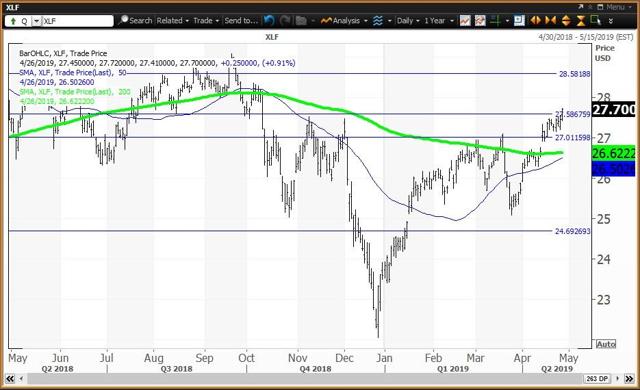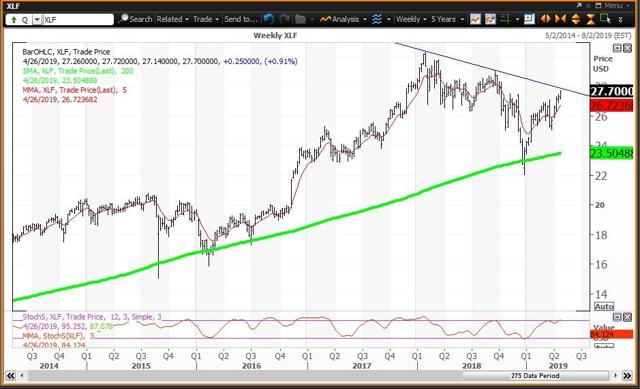[ad_1]
The Federal Reserve will release their latest FOMC Policy Statement on Wednesday, May 1st and their policy outlook will likely be similar to the statement released on March 30. In my opinion the Fed has frozen the federal funds rate at 2.25% to 2.50% through 2019 and potentially through the 2020 Presidential Election.
On March 20 the Federal Reserve put a time stamp on the unwinding of the balance sheet saying it will stop at the end of September. My call is that this will be an unwind-pause, and that unwinding will resume after the Presidential Election in 2020.
I came to this conclusion given Fed Chair Jerome Powell response to a conference call question on March 20 regarding the size he would like the balance sheet to be when the unwinding ended? His response was $3.5 trillion which would be a total unwinding of $1.0 trillion.
The “quantitative tightening” schedule called for a drain of $50 billion in March and April, then down to $35 billion each month over the next five months through September. This would total an unwinding of $275 billion. This would reduce the balance sheet down to $3.696 trillion, not $3.5 trillion. This would mean that another $196 billion of “quantitative tightening” would likely restart after the Presidential Election.
On April 24 the balance sheet was stamped at $3.928 trillion down $4 billion for the week. The balance sheet is marked every Wednesday, but not published until Friday. Beginning in October the Fed will be allowing $20 billion a month of agency securities to run-off but they will be replaced by U.S. treasuries. Most unwinding transactions will occur as securities mature. U.S. treasuries mature on the 15th of the month or at month. When a treasury matures, and the Fed needs to re-invest they will buy the new issue in the same cycle on a noncompetitive basis.
One issue that I disagree with is that Fed Chair Powell told his press conference audience that unwinding the balance sheet is not tightening monetary policy. How can it not be? Unwinding “Quantitative Easing” is “Quantitative Tightening” as money is drained from the banking system!
The Financial Select Sector SPDR Fund (XLF) has been ignoring quantitative tightening.
The Daily Chart for XLF
 Courtesy of Refinitiv XENITH
Courtesy of Refinitiv XENITH
The daily chart for XLF shows that the ETF had a bear market decline of 24% from its Sept. 20 high of $29.07 to its Dec. 26 low of $22.05. Since this low XLF is in a bull market 25.6% above the low with a gain of 16.3% year to date. Note that Dec. 26 was a “key reversal” day as the close at $23.32 was above the Dec. 24 high of $22.75. The Dec. 31 close of $23.82 was an important input to my proprietary analytics and its annual and semiannual pivots at $27.01 and $27.56, respectively. The close of $25.71 on March 29 was input to my analytics and resulted in a monthly value level at $24.69 and a quarterly risky level at $28.59. Note how the 50-day and 200-day simple moving averages are converging at $26.50 and $26.62, respectively. Be on the lookout for a “golden cross.”
The Weekly Chart for XLF
 Courtesy of Refinitiv XENITH
Courtesy of Refinitiv XENITH
The weekly chart for XLF is positive but overbought with the ETF above its five-week moving average at $26.72. The ETF is above its 200-week simple moving average or “reversion to the yield” at $23.50 which held at the beginning of the year. The 12x3x3 weekly slow stochastic reading rose to 84.12 up from 78.56 on April 18 rising above the overbought threshold of 80.00. Note the downtrend connecting the highs of February 2018 and the high of September 2018. This trendline comes in at $27.85 this week.
Trading Strategy: Buy weakness to the 200-day simple moving average at $26.62 and reduce holdings on strength to the quarterly risky level at $28.59. My annual and semiannual pivots remain magnets at $27.01 and $27.56, respectively.
How to use my value levels and risky levels:
Value levels and risky levels are based upon the last nine weekly, monthly, quarterly, semiannual and annual closes. The first set of levels was based upon the closes on December 31. The original quarterly, semiannual and annual levels remain in play. The weekly level changes each week; the monthly level was changed at the end of January and February. My theory is that nine years of volatility between closes are enough to assume that all possible bullish or bearish events for the stock are factored in. To capture share price volatility investors should buy on weakness to a value level and reduce holdings on strength to a risky level. A pivot is a value level or risky level that was violated within its time horizon. Pivots act as magnets that have a high probability of being tested again before its time horizon expires.
How to use 12x3x3 Weekly Slow Stochastic Readings:
My choice of using 12x3x3 weekly slow stochastic readings was based upon back-testing many methods of reading share-price momentum with the objective of finding the combination that resulted in the fewest false signals. I did this following the stock market crash of 1987, so I have been happy with the results for more than 30 years. The stochastic reading covers the last 12 weeks of highs, lows and closes for the stock. There is a raw calculation of the differences between the highest high and lowest low versus the closes. These levels are modified to a fast reading and a slow reading and I found that the slow reading worked the best. The stochastic reading scales between 00.00 and 100.00 with readings above 80.00 considered overbought and readings below 20.00 considered oversold. Recently I noted that stocks tend to peak and decline 10% to 20% and more shortly after a reading rises above 90.00, so I call that an “inflating parabolic bubble” as a bubble always pops. I also call a reading below 10.00 as being “too cheap to ignore.”
Disclosure: I/we have no positions in any stocks mentioned, and no plans to initiate any positions within the next 72 hours. I wrote this article myself, and it expresses my own opinions. I am not receiving compensation for it (other than from Seeking Alpha). I have no business relationship with any company whose stock is mentioned in this article.
[ad_2]
Source link Google News
